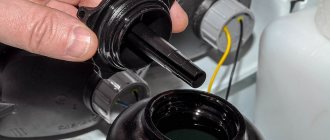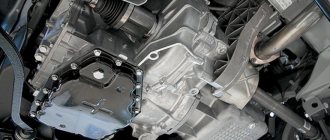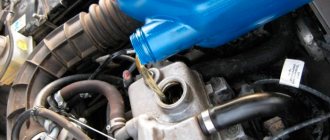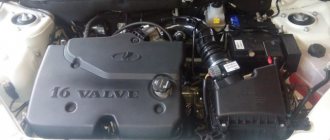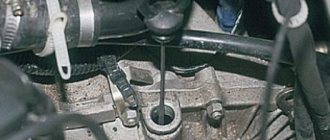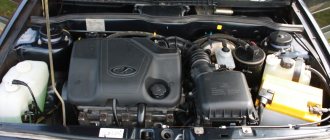Checking with a dipstick
- Place the car on a flat surface and wait for the oil to settle (10-15 minutes).
- We open the hood, find the gearbox dipstick, it is in the form of a black rubber ring (not to be confused with the engine crankcase dipstick). The dipstick is located on the gearbox; if you approach from the driver's side fender, it is located under the air filter tube.
- Having pulled it out, wipe it with a cloth and put it back.
- If you cannot reach the dipstick, you can remove the air filter.
- We pull it out and look at the dipstick reading.
The oil level should be at the max mark. If there is not enough oil, then add oil of the same brand through the dipstick hole, let it settle and look at the readings again.
It is also worth noting that the oil in the box should be slightly above the max level. The fact is that fifth gear is the highest, and therefore the level is not always enough. So fill above the max level, then you will avoid the hum of the fifth gear and extend its life. And the stories about the fact that if the oil is above the level, it will break the gasket - these are all old-fashioned legends.
What are the consequences of adding a large amount of mixture to the VAZ 2114?
- Sometimes you check and see too much oil in your car or engine, and sometimes you accidentally put too much oil in during engine maintenance?
- You think that more oil will help the engine run smoother. But actually it is not.
Let's find out the problem.
Pressure on the crankshaft head and shanks
Couplings and crankshaft ends are used to prevent lubricant from leaking out of the engine, mainly in the parts adjacent to the pulley (crankshaft) or flywheel side (tailshaft). The more oil is poured, the fewer cacti contain less air. When the engine is running, the piston moves up and down, creating thrust pressure.
Therefore, cactus oil puts higher pressure on the cactus and is more dangerous than on the ends and ends of the crankshaft. These gaskets are quite fragile and easily release oil from the engine. Especially on the flywheel side, and this can lead to oil spillage on the clutch.
Motor overload
As explained above, too much oil will cause the pressure in the cacti to increase, which can cause oil to overflow through the exhaust pipe. The role of this exhaust pipe is to help remove oil vapors and reduce the pressure created by the up and down piston process. Instead of releasing polluting oil, it removes oil vapor back into the combustion chamber through an air intake. In case there is too much oil in the cactus, it can be returned through the pipe, entering the combustion chamber through the inlet pipe. As a result, the suction hose becomes blocked by oil soot.
Crankshaft and wrist are curved
Excess oil in a vehicle causes more friction on the crankshaft and valve body when exposed to oil. Excessive resistance caused by engine oil causes them to bend and break.
Catalytic converter
Recirculating oil back into the combustion chamber, as mentioned above, causes black smoke, thick and greasy, after a period of time, which can destroy the catalytic converter as well as the diesel fuel particle filter (FAP). As a result, turbo rupture is even possible.
Checking the oil level without a dipstick
- We park the car on the overpass.
- We remove the protection.
- Unscrew the filler plug on the gearbox.
- We put our finger in there and feel if we touch the oil.
The oil should be up to the bottom of the filler plug. You can fill the oil with a special syringe (not a medical one).
But here again, there is a big disadvantage: there is not enough oil for 5th gear. To do this, we need to place the car on an overpass at an angle so that more oil can fit in. Fill it in, tighten the plug, and put everything back in the reverse order.
How to check the oil level in a VAZ 2114 gearbox is an important and relevant question at any time of the year. If its low level is not detected in time, a major overhaul of the entire gearbox may soon be required.
What quantity should I fill?
3.3 liters of oil
Take another litka for topping up!
Before going to the store, it would be nice to find out how much oil can fit in a VAZ-2114 box. This information should not be neglected, since buying excess oil will incur extra costs, but if you buy insufficient fluid, you will not be able to complete the oil change process completely.
If we ask the manufacturer for advice, we can understand that we need 3.3 liters of transmission oil. But you won’t find exactly this quantity in the store; there will be 1, 3 and 5 liters. Here it’s your choice, you can take two containers for a total of 4 liters, or you can buy 5 liters. The remaining oil will never be superfluous; you will always have it at hand at the right time.
How often should you check the oil level?
Once every two to three weeks, at least its level should be checked. Although for some car owners, time is not the best control measure. If so, then you can focus on the car’s mileage: check if everything is in order after every seventy thousand kilometers.
Negative consequences of a leak:
- Noises in the gearbox.
- Premature depreciation of parts.
- Significant costs for overhauling the gearbox.
It is worth distinguishing between two similar, but nevertheless different questions: “how to check the oil level in the gearbox” and “how to check its level in the engine.” These are completely different concepts and procedures. We are interested in the first.
There are two options for checking the oil level. It all depends on the presence of a dipstick in the car. We will tell you what this is a little later. Just keep in mind that until 2003, VAZ 2114 cars were produced without a dipstick.
Video about checking the level in the gearbox and adding new oil to a VAZ-2114
A manual transmission is a multi-stage helical gearbox with manual gear shifting. It can be from 4 to 7 steps. In cars of the Volzhsky plant, and in particular in the VAZ 2114 model, there are 5 stages. To put it simply, a gearbox is a combination of gears and shafts in close contact with each other, rotating at high speed. When working dry, such blocks will, on the one hand, overheat, and on the other, quickly wear out and wear out. And to prevent this from happening, it is necessary that all moving and contacting components of the box are continuously lubricated with special gear oil, which performs a dual task:
- on the one hand, it reduces friction between gears and gearbox shafts
- on the other hand, it provides cooling of parts.
That is why it is extremely important to ensure that the oil level in the VAZ 2114 gearbox, as well as other VAZ models, does not fall below the minimum point.
Oil filler neck and dipstick in gearbox
From this article you will learn how to check the oil in the gearbox of a VAZ 2114
Checking the oil in VAZ 2113, 2114 and VAZ 2115 cars is almost identical. To see where the oil level dipstick is located in the VAZ 2114 gearbox and other models, you need to remove the engine air filter. You will notice it as soon as you open the hood. The filter occupies the front part of the hood at the top. The dipstick is located below the thermostat; you can recognize it by the ring on the plug, which you need to carefully pull on . A rod called a probe is attached to the plug. The smeared dipstick should be wiped with a rag. There are two level marks at the bottom of the rod indicating the minimum and maximum level. Insert the dry wiped dipstick into its place and remove it again. By the end of the rod stained with oil, you will understand what the oil level is in the gearbox. Ideally, if it is in the middle between the marks. It's normal if the level is maximum. But if it reaches the min mark, or, even worse, below it, then the oil must be added. In the same way, you can check the oil in the box of a VAZ 2115.
VAZ models produced before 2003 do not have a dipstick. This is not very convenient, but, nevertheless, the level of lubricant in the gearbox must be checked. To do this, you need to crawl under the car and remove, if any, the crankcase protection, which blocks access to the gearbox filler plug. Unscrew it and plunge your finger into the container. If you cannot reach the oil with your finger, this means that you need to add it so that the oil covers the nail. Screw the plug back into place and install the protection.
Any self-respecting car enthusiast should know how to care for his vehicle, and in particular, how to add oil to the gearbox. Let's consider the moment when its level is at or below the minimum level. The hole from which the dipstick was unscrewed is the inlet for the lubricating fluid.
To regularly add oil to the gearbox, you need a special tool that you can make yourself. To do this, you will need a large funnel with a capacity of 500-750 grams with a spout and a hose up to half a meter long. The diameter of the hose should fit easily but tightly onto the spout of the funnel, and also fit freely into the inlet of the PP box. Fix the hose on the spout so that it does not jump off.
This tool is built to last and should be kept in the trunk of your car along with your other tools.
- Take a funnel with a hose,
- insert its lower end into the hole in the box,
- Start pouring oil from the bottle, periodically checking the level with a dipstick.
- As soon as you reach the optimal level, take a break, give the liquid time to spread throughout the box, filling the empty spaces between the parts.
- After about five minutes, check the level again with the dipstick. If it drops to the bottom line, add a little more.
What oil to add is up to you to decide, based on what the market offers. But it is recommended to add lubricant of the same brand (or close to it) that is already used in your car. When replacing it completely, you should take into account the recommendations of the manufacturer, which prescribes in the instructions which gear oils should be used. So, for cars such as the VAZ 2115, the GL 4 brand should be used, which is classified in Russia as TM 4. The manufacturer recommends using Lukoil TM 4-12 SAE 80W85.
All novice VAZ Samara car owners need to know how often they need to check the oil level in their car, as well as how often it needs to be changed. Moreover, these terms depend on
- Quality of the petroleum product used.
- mileage;
- Driving manners,
- The age of the car and, accordingly, the age of the engine;
- Climatic conditions. Temperature changes also affect the quality and efficiency of the oil.
Under optimal operating conditions, the transmission fluid is replaced after 60-80 thousand. km run. If the car is operated in critical and even extreme conditions (dirt roads, traffic jams, frequent transportation of goods, for example to the country, hot or, on the contrary, frosty climate), then the transmission lubricant should be changed much more often - after 25-30 thousand kilometers.
It is important to know that abrupt gear changes are unacceptable for operating the gearbox. The engine does not have time to slow down, and therefore the switching occurs with a blow. Such aggressive use leads to rapid wear and even chipping of gear teeth, and, accordingly, failure of the gearbox.
When checking the oil level, also pay attention to its color and consistency. If it has a thickened structure, has become cloudy, or has acquired a bluish-black color, foreign black inclusions have appeared in it, or a burnt smell, all this means that it is time to change it. Moreover, all these signs indicate that the gearbox itself also needs repair. With normal functioning of the gearbox, the petroleum product retains its properties and structure for a long time.
Content
A car transmission is a unit containing a large number of moving components and parts. It is for this reason that the oil poured into it must be of high quality and exactly meet the required parameters for fluidity, viscosity and other indicators. Today we will talk about which oil to choose for the VAZ 2114 gearbox and how to replace it correctly with your own hands.
Gearbox oil for VAZ 2114
Preparation for the procedure
Option one, if there is a dipstick, then the car needs to be placed on a flat horizontal surface.
If there is no dipstick, then, on the contrary, the car needs to be installed on an overpass, a lift, or an inspection hole.
Helpful advice: before starting the test, you need to wait ten to fifteen minutes. This interval is necessary after stopping the engine so that the liquid we are testing cools down and drains from the shafts and gears into the gearbox housing.
Verification procedure
The easiest way to monitor the oil level in the gearbox is with a dipstick. But where is the oil level dipstick in the VAZ 2114 gearbox and what is it?
Location of the gearbox oil level dipstick on a VAZ 2114
The probe looks like a metal strip at one end of which there is an o and “max”, and at the second, opposite end, the part ends with a black rubber ring.
Checking the oil level using a dipstick:
- Place the car on a flat surface.
- We wait the required fifteen minutes.
- We stock up on rags.
- Open the hood.
- On the side of the driver's fender we are looking for the black rubber ring of our part. It is located on the gearbox directly under the air filter tube for air purification.
- We take out the found ring.
- Wipe it dry with a rag prepared in advance.
- Carefully, without touching the walls, put the dipstick back until it stops.
- We take out and inspect the marks on the dipstick.
Transmission oil level
The optimal oil level in the VAZ 2114 gearbox shows about. If the actual level is below this mark, then the oil should be added.
Helpful advice: if you can’t get to the dipstick with the air filter attached, you can remove it.
Well, how to check the oil in the box of a VAZ 2114 if there is no such dipstick in it?
Test procedure without dipstick:
- We install the machine over an inspection hole or on an overpass.
- We free the bottom from the protective devices.
- We remove (unscrew) the plug from the gearbox.
- Place your finger there.
- Determine the oil level by touch.
It is necessary that the oil in the hole reaches the lower border and that your finger can feel it.
Step-by-step replacement instructions
Essential Tools You'll Need
- Oil to replace.
- The key is 17 (we will use it to unscrew the drain plug).
- The key is 8 (we use it to unscrew the air filter).
- Plastic bottles of 1.5 and 5 liters.
- Knife.
We stocked up on tools, then we need to drive the car onto an overpass and change the oil.
Stages (step by step instructions)
- Using a knife, cut off the neck of a 5-liter container and the bottom of a 1.5-liter container and set them aside for now.
- Using a 8mm wrench, unscrew the air filter and remove it so that it does not get in the way.
- We remove the gearbox dipstick from the hole to change the oil.
- We go under our car.
- Remove the protection (if any).
- We find and unscrew the drain plug of the gearbox using a 17 key. No difficulties should arise here, everything is extremely simple. ATTENTION! Be careful, when you unscrew the plug, oil will rush towards the front left wheel. As soon as the pressure weakens a little, we substitute our large container and pour everything into it.
- When everything is drained, tighten the drain plug.
- We get out from under the car.
- Insert a funnel into the oil change hole from which you removed the dipstick.
- Using a 1.5-liter container, pour 3 liters of oil into the funnel. You need to pour it slowly so as not to accidentally spill it.
- Temporarily put the bottle aside, take the dipstick and check the level. If it reaches the MAX mark, great, if not, add a little more.
- We wipe and put the dipstick in place.
- Ready! Replaced. The gearbox of your VAZ 2114 has found a new life.
Take care of your car's transmission, use only the correct and high-quality oil, replace it on time and do not forget to check its level. Then you will not have any problems, and the gearbox will serve you for many years.
How to add oil if its level is low?
If there is a dipstick, oil is poured into the same hole where it went down. For convenience, you can use a rubber hose with an appropriate connector and a homemade funnel made from a plastic bottle attached to it. And then check again with a dipstick. Experienced car owners recommend pouring a little more oil, about five millimeters above the maximum mark. This is important for those who often use fifth gear. After all, she is higher than her predecessors and may not have enough oil. Additional millimeters of oily film at the dipstick mark will eliminate the hum when switching to fifth gear, and will also protect it from rapid wear. However, here it is also important to know when to stop: if you overfill the oil, the gaskets and seals may deteriorate, and the consumption of the replaced fluid itself will increase. Although, debates about the correctness of such a warning are still ongoing among car owners.
Important detail
The missing fluid must be topped up with the same brand that has already been poured into the car.
Regular checks will protect the car owner from premature and expensive gearbox repairs. Moreover, this procedure is simple and takes only fifteen minutes.
The manual gearbox of front-wheel drive VAZ cars is simple in design, but nevertheless requires a certain amount of attention, sometimes no less than the robotic and hydromechanical gearboxes of foreign cars. First of all, the VAZ-2114 gearbox suffers from the quality of the lubricant and its quantity . That is why it is important not only to fill in high-quality transmission oils, but also to monitor their level.
We check the oil level in the gearbox in a VAZ-2114 of different years of production
Gears, shafts and synchronizers, as well as gearbox bearings, operate under very difficult conditions and experience significant loads. The temperature in the gearbox sometimes rises above 150 degrees and the mechanism requires not only active lubrication, but also cooling. Apart from transmission oil, nothing cools the box, which is why it is necessary to monitor the oil level in the gearbox housing.
Once the oil level drops below normal, gears and bearings wear out very intensively, which leads to premature repair and replacement of synchronizers, gears and bearings.
Without dipstick
In front-wheel drive VAZ cars produced before 2003, a dipstick for checking the oil level was simply not provided , so in such Samaras it is somewhat more difficult to check the oil level, but no one has canceled this procedure. This is done as follows:
- The engine crankcase protection is removed.
Removing the crankcase protection
Unscrew the plug from the oil filler hole
The oil level in the gearbox without a dipstick should be such that it completely covers the first phalanx of the finger . Not the most technologically advanced verification method, but nevertheless it is the only one.
It is important to remember: before checking the oil level in the gearbox of a VAZ-2114 of any year of manufacture, the car must stand for at least 15-20 minutes with the engine turned off on a flat surface so that the transmission drains from the walls of the gearbox and gears. Only then will the test results be objective.
Transmission oil level with dipstick
Checking the oil level with a dipstick is much easier, and the process will greatly simplify dismantling the air filter. The fact is that the gearbox dipstick is located just under the filter on the driver's door side, although it can be reached without removing the air cleaner housing.
Optimal oil volume for a manual gearbox
The required volume of oil in a manual transmission is a purely individual concept for each vehicle. Machines of different models differ significantly from each other not only in appearance, but also in design features. Transmission components are no exception, in particular the gearbox, which is responsible for driving the vehicle and changing gears. Accordingly, the amount of lubricant in a manual transmission is individual for each car, and you can see it in the user manual for the vehicle, where the manufacturer indicates the exact displacement of the transmission unit, the type of recommended oil, as well as its optimal level in the system.
Why is it so important that the oil level in a manual transmission exactly meets the standards specified by the car manufacturer? The fact is that the transmission fluid performs tasks that are important for the correct functioning of the gearbox: it removes heat from working surfaces, facilitates the operation of contacting parts, and removes slag components that are formed during friction. If the oil in a manual transmission is less than normal, it ceases to cope with its functional duties. A low oil level first results in a deterioration in the vehicle’s handling, a decrease in its safety on the road, and subsequently, without taking corrective action, it threatens the car owner with gearbox failure and costly repairs.
The following symptoms may indicate that the manual transmission is low on oil:
- transmission slipping when changing gears;
- the lever is very difficult to fix in a certain position; any of the gears, or several at once, may not engage the first time;
- When you try to change gear, the car starts to vibrate or even stall.
Among the signs of low oil level, attentive drivers also note uncharacteristic noises and vibrations from the transmission, a decrease in the speed of the car’s response to gear changes. Excess oil, as well as low oil level, is no less dangerous for the gearbox. If you fill the box with oil in excess of the permissible volume, the liquid will begin to squeeze out the sealing elements during intensive work and flow out. As a result of the leak, the system will return to the problem of low lubrication levels, which is fraught with the consequences described above. Underfilling, as well as overfilling, ultimately leads to disastrous consequences in the form of mandatory manual transmission repairs.
You can prevent malfunctions from the manual transmission by carefully listening to your vehicle and reacting to the slightest deviations from the norm in the operation of functioning components, performing service work in accordance with the manufacturer’s regulations. At the same time, it is important to diagnose the oil level in the manual transmission at least every five thousand kilometers; if the level of transmission emulsion deviates from the norm, immediately top up the lubricant or drain excess fluid if there is excess.
